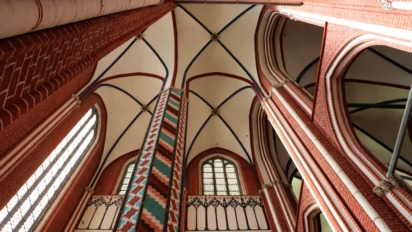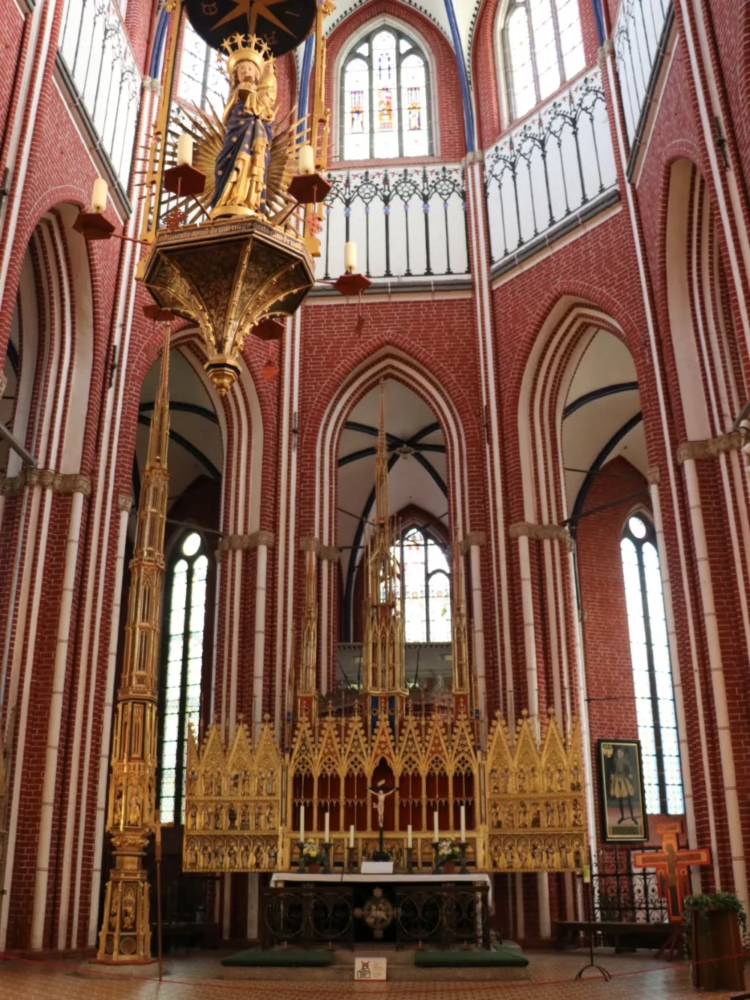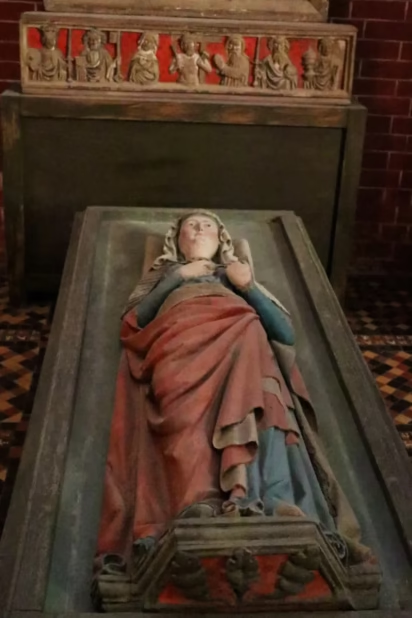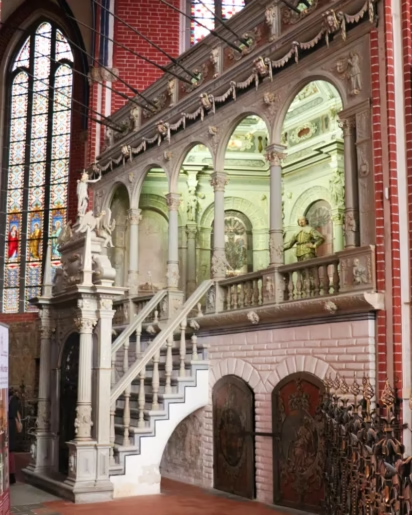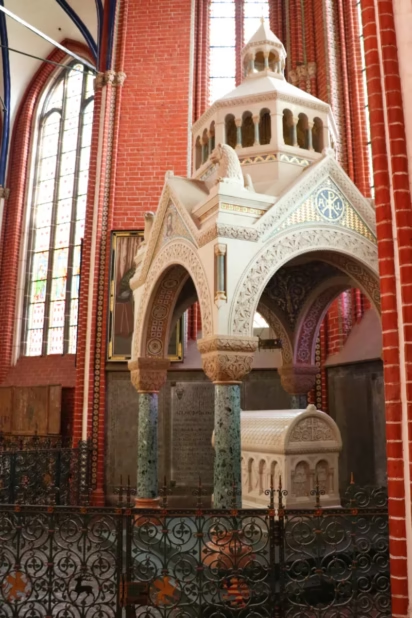Visit the Doberan Minster (Doberaner Münster) in Northern Germany to see one of the finest Brick Gothic churches with important artworks in the magnificent original medieval interior.

The Doberaner Münster is an important former monastery church located near Rostock in Mecklenburg-Vorpommern in northern Germany. It is one of the most impressive sights on the European Route of Brick Gothic. In addition to its magnificent architecture, it has the best-preserved medieval interior of any former Cistercian abbey church in Europe. Top artworks here include the oldest existing wing altar in Europe, the tallest Gothic tabernacle in Germany, a monumental double-sided cross altar, and many further church fittings dating from before 1300 and the 14th century. The church was the burial site of the rulers of Mecklenburg from 1302 to 1920 and further graves include the oldest tomb sculpture in the region, which was also the first female tomb sculpture in any Cistercian church. The Doberan Minster is an easy stop when traveling by car, rail, or bicycle in the Rostock region of the Baltic Coast in Northern Germany.
Visit the Brick Gothic Münster in Bad Doberan
The magnificent Brick Gothic Doberaner Münster (Minster in Bad Doberan) is arguably one of the most beautiful churches in Germany. Constructed in a short period and with generous financial and political support, the spectacular church was largely left on the sidelines of political and economic developments for centuries and thus preserved in a very fine condition.
Although the final consecration of the church was only in 1368, the basic structure of the present Brick Gothic church at the Cistercian Monastery at Doberan was completed in 1296 after a building period of fewer than 20 years. The abbey church built in brick followed the typical French gothic floorplan of a triple nave basilica. It is 79 m long and 39 m wide with the height of the central nave 26.5 m and the tower 72 m. Not cathedral proportions but still fairly large for a medieval monastery church in northern Germany.
Although the church architecture followed the Cistercian prescription of no bell towers or elaborated western facades, by the time of completion, the monastic principle of simplicity was clearly ignored when the interior was richly decorated and all windows used colorful stained glass.
Mecklenburg, often seen in Germany as the epicenter of provincial backwardness in modern political jokes, was a major political power for centuries with its dukes influential right up to the late 19th century. For over six hundred years, the rulers of Mecklenburg preferred the Doberaner Münster as a burial site ensuring financial support not only for the initial construction but also for the maintenance of the church.
Although the monastery was dissolved in 1552 following the Lutheran Reformation, the art and furnishings of the church were not destroyed. The damage was done by looting during the Thirty Years’ War while using the church as a storage depot during the Napoleonic occupation caused further destruction to furnishing.
Like many other major historic buildings in provincial Germany, overenthusiastic restoration in the late 19th century damaged much of the original art and fittings but probably saved the structure from collapse. The Doberaner Münster survived the Second World War intact and in the Communist DDR was considered among the third most significant monument of international artistic and cultural importance in East Germany. A restoration with limited means but great attention to color accuracy was completed in 1984. The current very comprehensive restoration project started in 2002 and although ongoing, most of the major elements have been restored.
Art in the Brick Gothic Doberaner Münster
The Münster in Bad Doberan is as much visited for its magnificent brick gothic architecture as the beautifully decorated interior with artworks of international cultural importance. It not only has the richest medieval interior furnishings of any Cistercian church in Europe but also some of the earliest church art in existence.
Art in the Choir of the Doberaner Münster
The artistic highlights of the interior furnishings of the Minster in Bad Doberan are the artworks from around 1300 in the altar area of the choir.
Oldest Wingaltar in Art History

The wing altar, around 1300 by unknown artists, in the Doberan Minster is considered the oldest surviving wing altar (Flügelaltar) in art history. As a Cisterian monastery church, this Hochaltar (high altar) was dedicated to Mary, Mother of Christ. This enclosed altar thus focused on events from the life of Mary. The illustrations on the left wing are thus sometimes referred to as the Joys of Mary, e.g. events from the birth of Christ while the right shows the Sorrows of Mary, including the Passion of Christ. The figures from the center panel, where space was also used by monstrances and relics, were lost during the Thirty Years’ War. The scenes from the Old Testament and the row of apostles were added around 1360.



The Sakramentsturm (tabernacle) from 1360-70 is the tallest and one of the oldest in Germany. This Gothic monstrance measures 11.6 m high and was used to store the sacred host (until the Lutheran Reformation) and probably hosted further relics and richer decorations. The figures on the lower level are from the Old Testament (including King David playing the harp, Abel sacrificing a lamb, Moses with manna), and on the higher level from the New Testament (including Mary and various apostles).
The Kehlschrank (chalice cupboard), ca. 1300, has decorations unique in Europe from the period. The paintings on the inside of the doors — generally not shown — are the originals and were never repainted. It had space for 20 sets of utensils — two for the main altars and 18 for the altars in the side chapels.
The triple-seat Levitengestühl (Levite pews) and Kredenzschrank (credenza) are similarly from around 1300, while the seats of the monks in the choir are from the period 1300 to 1370. The eagle pulpit and the chancel are 19th-century additions.
High up in the choir hangs the Marienleuchter (Mary candle holder). This is a medieval composite artwork: the madonna with child dates from just before 1300 and was originally at the center of the wing altar. Around 1400, the statue was replaced by a silver one and repurposed as an apocalyptic crescent moon Mary. This refers to the scene in Revelations 12:1, the last book in the standard Bible, “A great sign appeared in heaven: a woman clothed with the sun, with the moon under her feet and a crown of twelve stars on her head.” It is one of the oldest of its kind in Germany.
Double-Sided Cross Altar in the Bad Doberan Minster




The Doppelseitiger Kreuzaltar (double-sided cross altar) in the Doberaner Münster is another monumental work of art historical importance. It dates from around 1360 and is one of the largest and most elaborately decorated of its kind in Europe from the period.
In addition to the art on the cross, it was further enhanced by large wine leaves growing out of the wooden cross to symbolize the tree of life. These large leaves were restored in 1982 using medieval colors. The oak leaves are covered by a thin metal layer. As the oxidation process continues, the bright green should eventually become duller. In contrast, the dull golden on the cross was painted in the 19th century while the original medieval gold-covered areas still shine brightly.
The Mary side — facing the choir and the parts of the church originally reserved for the monks — is illustrated mostly with scenes from the lives of Christ and Mary including the annunciation, birth of Christ (not very stable-like here), Moses and the burning bush (center), presentation in the temple of Christ (gold) and Samuel (silver), and the always easy to decipher flight to Egypt.
The Christ side has a large crucifixion at the center and a variety of biblical scenes from both the Old and New Testament. Some of the easier and more familiar scenes include Christ on the Mount of Olives (left), the Fall of Man (center with modesty protected by a further set of small doors), Jesus carrying the cross, and Job with the devil (second from left). On the cross, from the bottom: Abraham offering Isaac, Jacob fighting the angel and the stairway to heaven, Samson destroying the city, and on the right arm: David and Goliath.
Furnishings and Stained-Glass Windows in the Nave



The Laiengestühl (pews of the lay brothers) are amongst the oldest items in the church — it dates partly from 1280, although the canopies were added later. Art carved on the pew ends includes an eagle, pelican, lion, wolf, and a dragon — all laced with religious symbolism familiar to the medieval Christian.
The Romanesque baptismal font, ca. 1300, is originally from Marienkirche in Wismar.
The stained-glass windows are a mixture of medieval and nineteenth-century restoration projects. Small sections are from 1300 but most are neo-Gothic. In contrast to many other Cistercian monastery churches, the windows of this abbey church were completely covered in colorful stained glass during the 14th century. (For very impressive original medieval stained-glass windows visit Stendal in Saxony-Anhalt — now a provincial backwater but very important during the middle ages.)
Only the face of the astronomical clock from 1390 survived the looting and destruction of the Thirty Years’ War. The main function of these elaborate clocks was to determine the feast days of various saints in the religious calendar of the Roman Catholic church.

As in so many other German churches and monuments, the memorials for the dead of the Second World War are so much less elaborate than for the First World War. In many cases, the later memorials were only added much later and sometimes not at all. Also fairly common, as here, is an additional memorial to all victims of war and violence.
Graves and Tombs in the Münster in Bad Doberan
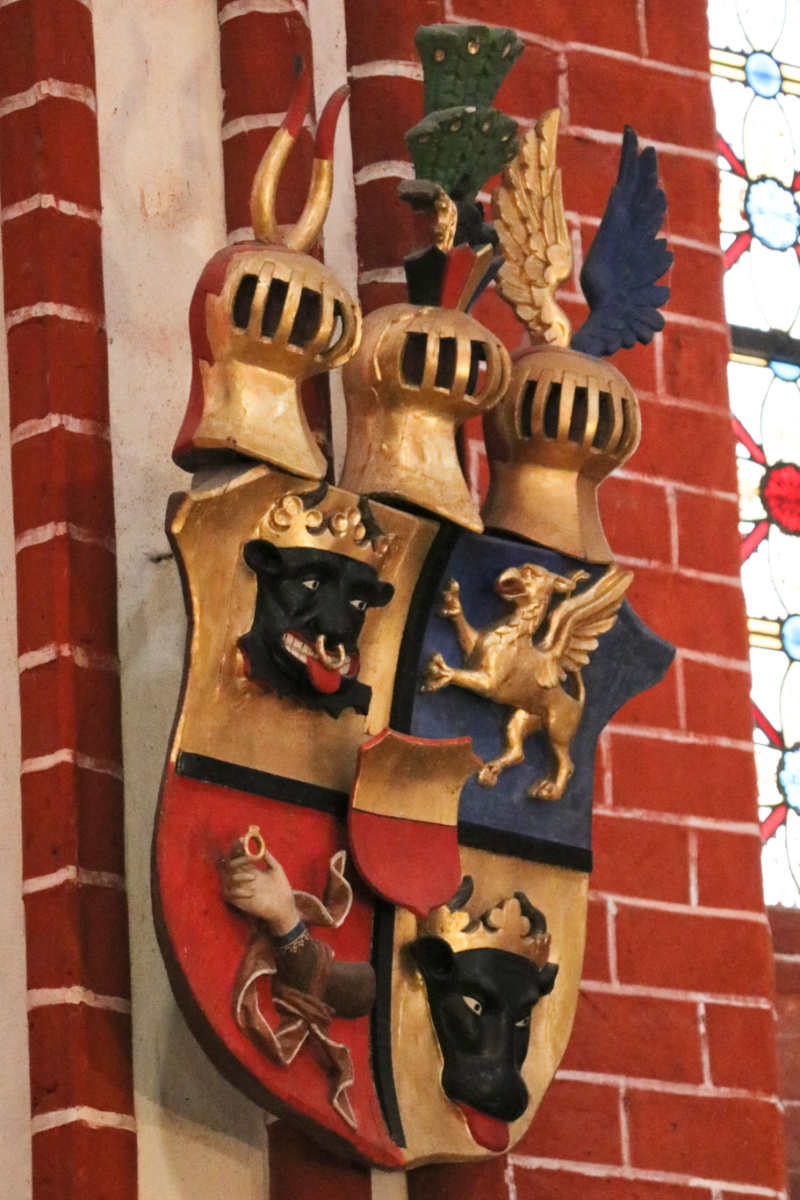


Like any Gothic church, the Doberaner Münster is filled with graves, funeral monuments, and epitaphs. It was the preferred burial site of the rulers of Mecklenburg from 1302 to 1920 but abbots and further prominent individuals were also buried here.
At the rear of the church is the granite sarcophagus of Archduke Friedrich Franz I (died 1837) — he is best remembered for finding Bad Heiligendamm — the first seaside resort (for the nobility) in Germany. (It is still a popular excursion on the Molli steam train, or vice versa.) His tomb was moved from the high altar to the less important location only in 1976.
Other tombstones, including those of the abbots, were similarly moved in recent years and mounted off the walls to allow air circulation to prevent further salination and damage caused by being mounted on the wall or being set into the church floor.
The paintings are mostly of Mecklenburg rulers and spouses.
The interior of the Bülow Family chapel is from the 19th century. Above it, some of the 3220 pipes of the Schuke organ are seen. The organ from 1980 has 44 stops and is played via three keyboards — concerts are frequent, especially during summer months (usually Friday evenings) and during advent.
The Pribislavkapelle is a funeral site of the Mecklenburger rulers since 1302. Pribislav (died 1178) was the first Christian ruler of this region and the founder of the original monastery. The colorful columns with tile decorations inspired by the orient are from the 14th century but the windows and memorial plates are 19th-century additions.
The two statues mounted near the entrance to the ambulatory are Duke Balthasar (died 1507) and Duke Erich (died 1508) and fine examples of epitaphs in the transitional period from the Gothic to Renaissance.
The painted Mühlen Altar (Mill Altar) from 1410. It literally shows the transformation of the Word of God to the flesh (eucharist) through a mill operated by 12 apostles.
The scale model of the monastery complex as it was around the time of the reformation in the 16th century.
Foundation Myth of Doberan Monastery
The first chapel in the choir shows a horse statue at the tomb of Samuel von Behr (1621) — he was an important chancellor and educator. The swan and antlers (Hirschgeweih) are symbols of the monastery’s foundation. The original Cistercian monastery was founded nearby at Althof in 1171. It was damaged in a war and the duke decreed that the new monastery would be built where he kills his first stag. Although the kill happened on swampy land, a swan came out and quacked “dobr, dobr” — Slavic for good. The new monastery was duly built here and called Doberan (Good Place).
Whatever the legend — the Cistercians frequently preferred hostile environments rejected by others. The monastery was built and the swampy land required 5-m deep foundations for the church and special glazed bricks and building techniques to prevent erosion. Surviving seven centuries certainly bears testimony to their dedication.
Queen Margrethe of Denmark – Oldest Female Grave Tomb Sculpture in Mecklenburg
The next chapel has three altars from the early 14th century but the really interesting item is the grave tomb of Queen Margrethe of Denmark (c. 1230 – 1282) with carved oak sculpture. This is the oldest female grave tomb in any Cistercian church in Europe and the oldest tomb sculpture in Mecklenburg-Vorpommern. Her life was even more interesting. Margaret Sambiria was the daughter of the Duke of Pomerania and Matilda of Mecklenburg. In 1252, she became Queen of Denmark when her husband became Danish King Christoffer I (1219-1259) through the principle of agnatic seniority — the younger brother of the king inherits before the eldest son of the dead king.
When King Christoffer died, possibly of poisoning, she had the principle of agnatic primogeniture applied and succeeded in being officially declared the regent for their minor son, the later Eric V. Nor surprisingly, this was disputed. Several battles were fought, she lost, was captured but escaped, and ruled rather well until Eric V reached adulthood in 1264. During her rule, she successfully petitioned Pope Urban IV to declare that in the future a woman could inherit the Danish crown — she feared Erik V would die (or be killed) before he had a son and would rather one of his sisters inherit the crown than his uncle.
As Margrethe was queen consort and later regent rather than a ruling monarch, she received no number but it is possibly no coincidence that both ruling Danish queens were also named Margrethe.
Renaissance-Baroque Ducal Grave Monuments
A century after the Reformation, it was probably easy for Duke Adolf Friedrich I of Mecklenburg (died 1658) to claim what is usually the Mary chapel for his own grave as well as his wife Anna Maria von Ostfriesland (died 1634).
This chapel on a higher level is decorated in a late Renaissance, early Baroque style. The monument is in limestone but the ceiling and other detailing are carved wood. Such lifesize states of the duke and duchess were popular in the period and were referred to as the Spanish style.
The Octagon from the late 14th century is the burial chapel for 13 dukes of Mecklenburg. It was built in 1370 but re-used various columns and capitals from the previous Romanesque church.
Tomb of the King of Sweden

The tomb of the King of Sweden and Duke of Mecklenburg, Albrecht III (1338-1412), and his wife Richardis (she died already in 1377) is an important example of Gothic royal grave art. The folds in Richardis’ dress are particularly detailed. The lion at his feet symbolizes strength and the dog at hers loyalty — both a bit ironic given his life story.
But so is the link to Margrethe of Denmark. Not Margrethe Sambiria but rather Queen Margrethe of Denmark (1363-1412) — she only became Margrethe 1 after the succession of Margrethe 2 to the Danish crown in 1972. (The Danish royal family, rather uniquely in Europe, uses Arabic rather than Roman numerals. Margrethe 2 is after Margrethe 1, the only female ruling monarch ever in Denmark. Following the death of Queen Elizabeth II in 2022, she is the longest-reigning head of state in Europe and Europe’s only ruling queen.)
To make a long story short, Margrethe I defeated Albrecht III in battle in 1389 and held him with his oldest son prisoner for six years until he signed over the Swedish crown to Denmark, allowing the Danish to rule Denmark, Norway, and Sweden in the Kalmar Union from 1397 to 1523. He returned to Germany to rule as Duke of Mecklenburg-Schwerin but was forced to formally abdicate the Swedish throne in 1405, increasingly lost support as his finances were strained, and finally died seven months before Margrethe.
Across from the Swedish grave is an interesting memorial statue of Duke Magnus II, died 1503. The sculpture is typical for the period and shows him wearing an death cloth around his neck.
The final ducal grave chapel is also the newest: Duke Johann Albrecht II (died post-German revolution in 1920) and his wife Elizabeth (1908). This chapel was painted in the neo-gothic style in the late 19th century but the graves are inspired by the Byzantium style of Ravenna which was very popular in Germany during the Kaiserreich period.
(See amongst others the Schaumburg-Lippe Mausoleum in Bückeburg and even the restoration of the Kaiserdom in Aachen.)
Visit the Brick Gothic Münster in Bad Doberan

Doberaner Münster Opening Hours and Tickets
It is easy to visit the Brick Gothic Münster in Bad Doberan as opening hours are long and the church is usually only closed on Good Friday and 24 December.
The Minster in Bad Doberan is open to visitors from May to October: daily from 10:00 to 17:00, opening at 11:00 on Sundays and holidays. In the winter season, the church may close already at 16:00.
The church sees over 200,000 annual visitors and is busiest from April to October between 11:00 and 15:00 when no tour bus passes through northern Germany without calling here. It is also a popular excursion for cruises calling at Rostock and holidaymakers at various Baltic Sea resorts.
Admission is €3. The guided tour in German, enquire for English, Swedish, or French, is usually at 11:00 (and 14:00 during summer) and is absolutely worth the small extra fee. Tours of the roof and bells are often offered at 13:00.
Transportation to Visit the Brick Gothic Münster in Bad Doberan

The Doberaner Münster is located at Klosterstraße 2, 18209 Bad Doberan, near the Baltic Coast in the German state Mecklenburg-Vorpommern. It is 15 km from Rostock on road B105 or 40 km from Wismar. From the Autobahn A20 use the exit for Bad Doberan. Parking is available directly at the church.
Bad Doberan is also easily reached by train. Trains arrive mostly hourly from Rostock in around 20 minutes or from Wismar in 45 minutes. It is a 10-minute walk from the station to the church.
A more interesting and very popular way to arrive in Bad Doberan is on the narrow-gauge steam train “Molli” from the beach resorts Kühlungsborn and Bad Heiligendamm — use either stop Goethestraße or Stadtmitte for visiting the Münster. The train operates 365 days of the year with hourly departures from April to October. On concert Fridays, special deals are usually available to use the train to Bad Doberan and return by bus after the concert.


